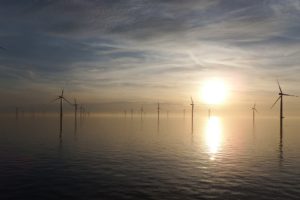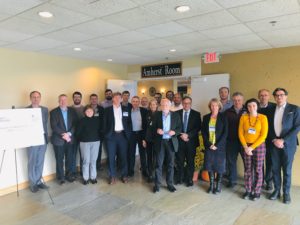Karla Hagan
Head of Science and Innovation Network, Washington, DC
Guest blogger for Science and Innovation Network USA
Part of Global Science and Innovation Network
12th December 2019 Science Innovation USA
SIN Spins up Flurry of UK-US Collaboration in Offshore Wind Energy Innovation Ahead of COP26
The UK’s global leadership in clean growth is clear. It is the first major economy to legislate for net-zero emissions by 2050, and in order to help developing countries take action the UK has committed to doubling International Climate Finance contributions by 2025. Within the clean energy sector, offshore wind energy deployment in the UK represents a whopping 34% of the world’s total installed capacity. As the UK prepares to host COP26 in partnership with Italy in November 2020, the Science and Innovation Network’s work in the US highlights UK expertise internationally, promotes global collective action, and furthers the deployment of clean energy in the United States.

In October, SIN convened a delegation of UK offshore wind energy researchers to attend the North American Wind Energy Academy/WindTech conference at the University of Massachusetts Amherst and to participate in a bilateral workshop with US partners. This workshop capped off two years of SIN work to scope out the US offshore wind innovation landscape, develop relationships, and investigate synergies around a $20 million US Department of Energy offshore wind energy demonstration project. Working in conjunction with UKRI, policy teams, and the Department for International Trade every step of the way, the first year resulted in Innovate UK securing £1.7 million from UKRI’s Fund for International Collaboration to support UK SME’s partnering on applied R&D with US organisations that have secured Department of Energy funding from the demonstration project.
Now in year two, the objectives of the bilateral workshop were to share current research collaborations and to devise new collaborations with identified potential funding sources. The workshop affirmed a strong appetite to collaborate across the Atlantic, with researchers clearly seeing the mutual benefit and refining ideas to a final list of seven projects with eight potential funding sources identified – more projects than anticipated at the outset! The seven collaborative projects being carried forward include lowering the cost of robust and low-impact shared anchoring systems, understanding the US supply chain in a global context, and sharing data and deepening understanding of the fishing industry, environmental, and social components of offshore wind.
 One of the things the project emphasised for me was the power of building relationships. Planting the seeds of trust between SIN and researchers on both sides of the Atlantic, and between the researchers themselves, was instrumental in the project’s success. It took scoping projects, several face-to-face meetings, and dozens of phone calls to pull off a well-organised and highly productive workshop – and to make it fun!
One of the things the project emphasised for me was the power of building relationships. Planting the seeds of trust between SIN and researchers on both sides of the Atlantic, and between the researchers themselves, was instrumental in the project’s success. It took scoping projects, several face-to-face meetings, and dozens of phone calls to pull off a well-organised and highly productive workshop – and to make it fun!
Through this programme of work, the Science and Innovation Network is advancing the UK’s clean growth goals. The US is aggressively building its offshore wind capacity with state commitments quadrupling since 2017[1]. Partnering to solve offshore wind technological hurdles together will accelerate the US on its path to deploying low-carbon offshore wind power generation. In addition, these collaborations and SME partnerships help launch joint ventures and build relationships to open up the growing US market to the expertise and supply chain of a more developed UK private sector. The work enables the kind of increased global clean energy deployment that will allow the world to meet the ambitious commitments needed at COP26, and beyond.
[1] US Department of Energy National Renewable Energy Laboratory, 2018 Offshore Wind Technologies Market Report, p 18.









